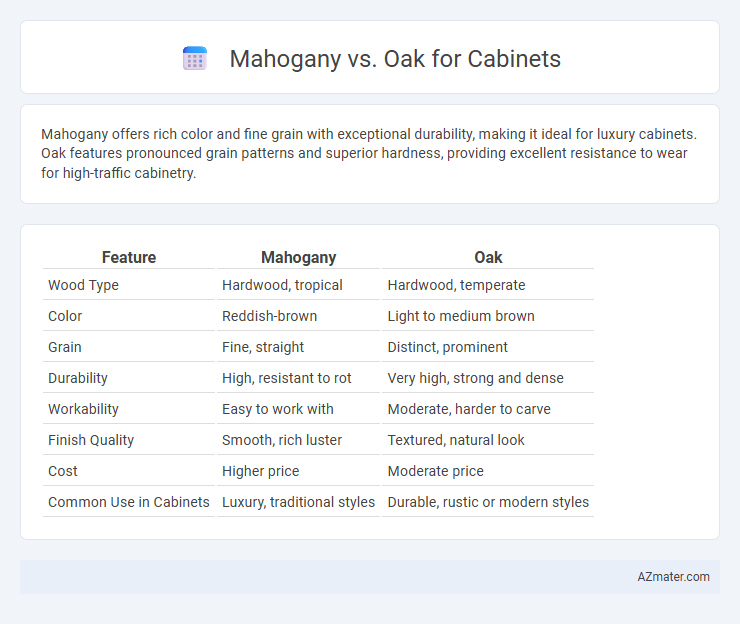Mahogany offers rich color and fine grain with exceptional durability, making it ideal for luxury cabinets. Oak features pronounced grain patterns and superior hardness, providing excellent resistance to wear for high-traffic cabinetry.
Table of Comparison
| Feature | Mahogany | Oak |
|---|---|---|
| Wood Type | Hardwood, tropical | Hardwood, temperate |
| Color | Reddish-brown | Light to medium brown |
| Grain | Fine, straight | Distinct, prominent |
| Durability | High, resistant to rot | Very high, strong and dense |
| Workability | Easy to work with | Moderate, harder to carve |
| Finish Quality | Smooth, rich luster | Textured, natural look |
| Cost | Higher price | Moderate price |
| Common Use in Cabinets | Luxury, traditional styles | Durable, rustic or modern styles |
Introduction to Mahogany and Oak Cabinets
Mahogany cabinets are prized for their rich, deep reddish-brown color and fine, straight grain, providing a luxurious and classic aesthetic suitable for high-end cabinetry. Oak cabinets feature a prominent grain pattern and vary from light golden to medium brown hues, offering durability and a timeless, rustic or traditional appeal. Both woods are hardwoods valued for strength and longevity, but mahogany tends to be more expensive and resistant to warping compared to oak.
Wood Characteristics: Mahogany vs Oak
Mahogany is prized for its rich, reddish-brown color and smooth, fine grain that creates an elegant, uniform appearance in cabinets, while oak features a more prominent, coarse grain pattern with a lighter, golden to medium brown hue enhancing rustic or traditional styles. Mahogany's wood density and natural resistance to decay contribute to exceptional durability and stability, whereas oak is known for its hardness and strength, providing sturdy, long-lasting cabinetry that withstands heavy use. Both woods offer excellent workability and finish absorption, but mahogany tends to take a higher polish for a sleek, luxurious finish compared to oak's more textured, natural aesthetic.
Color and Grain Differences
Mahogany cabinets feature a rich, reddish-brown color with a smooth, straight grain that often exhibits subtle wave patterns, creating a warm and elegant appearance. Oak cabinets display a lighter, honey to medium brown color with a prominent, coarse grain characterized by distinct rays and flecks, offering a rustic and textured look. The color depth and grain complexity of mahogany provide a more luxurious finish, while oak delivers durability with a naturally pronounced pattern.
Durability and Hardness Comparison
Mahogany offers excellent durability with a Janka hardness rating of around 800 to 900, making it resistant to dents and wear, ideal for long-lasting cabinetry. Oak, particularly white oak, is harder with a Janka rating around 1,360, providing superior resistance to scratches and heavy use in kitchen or bathroom cabinets. Both woods ensure sturdy cabinet construction, but oak's higher hardness makes it better suited for high-traffic areas requiring maximum toughness.
Cost Considerations: Mahogany vs Oak
Mahogany cabinets typically have a higher cost due to the wood's rarity and rich reddish-brown hue, often priced between $15 to $30 per board foot, compared to oak, which is more abundant and generally costs around $5 to $15 per board foot. The maintenance expenses for mahogany can be higher because it requires specialized finishes and conditioning to preserve its natural luster, whereas oak's durability and resistance to wear make it a cost-effective option for long-term cabinetry. Budget-conscious homeowners may prefer oak for its affordability and ease of upkeep, while those seeking premium aesthetics and exclusivity might invest in mahogany despite the elevated price point.
Maintenance and Care Requirements
Mahogany cabinets require regular dusting and occasional polishing to maintain their deep, rich color, with protection from excessive moisture to prevent warping or discoloration. Oak cabinets are more durable and resistant to moisture but benefit from routine cleaning with mild soap and prompt attention to spills to avoid staining. Both woods absorb finishes well, but mahogany's fine grain demands gentler care to preserve its smooth texture, whereas oak's coarse grain tolerates more robust cleaning methods.
Environmental Impact and Sustainability
Mahogany, often sourced from tropical rainforests, faces significant sustainability challenges due to slow growth rates and deforestation, making it less environmentally friendly compared to oak. Oak trees, commonly grown in temperate regions and managed through sustainable forestry practices, offer a more renewable and eco-friendly option for cabinetry. Choosing oak cabinets supports better carbon sequestration and reduced habitat destruction, aligning with sustainable material goals.
Aesthetic Appeal in Kitchen Design
Mahogany offers a rich, deep reddish-brown hue with a smooth, fine grain that enhances kitchen cabinets with a luxurious and classic aesthetic. Oak features a lighter, golden to medium brown color with a prominent grain pattern, providing a warm, rustic charm ideal for traditional and farmhouse-style kitchens. Choosing between mahogany and oak for cabinets depends on whether a designer prefers the refined elegance of mahogany or the robust, textured look of oak to complement the overall kitchen design.
Pros and Cons of Mahogany Cabinets
Mahogany cabinets offer exceptional durability and rich, deep color, making them a popular choice for luxury kitchen designs due to their resistance to warping and decay. The wood's fine grain allows for smooth finishes and intricate detailing, enhancing aesthetic appeal but often comes at a higher cost compared to oak. However, mahogany can be more prone to scratches and requires regular maintenance to preserve its luster, contrasting with oak's greater hardness and stain resistance.
Pros and Cons of Oak Cabinets
Oak cabinets offer exceptional durability and resistance to dents and scratches, making them ideal for high-traffic kitchens. Their prominent grain patterns provide a classic, warm aesthetic, but this can be less desirable for those seeking a more subtle or modern look. Oak is generally more affordable than mahogany, yet it may require periodic sealing to prevent moisture damage and maintain its appearance over time.

Infographic: Mahogany vs Oak for Cabinet
 azmater.com
azmater.com